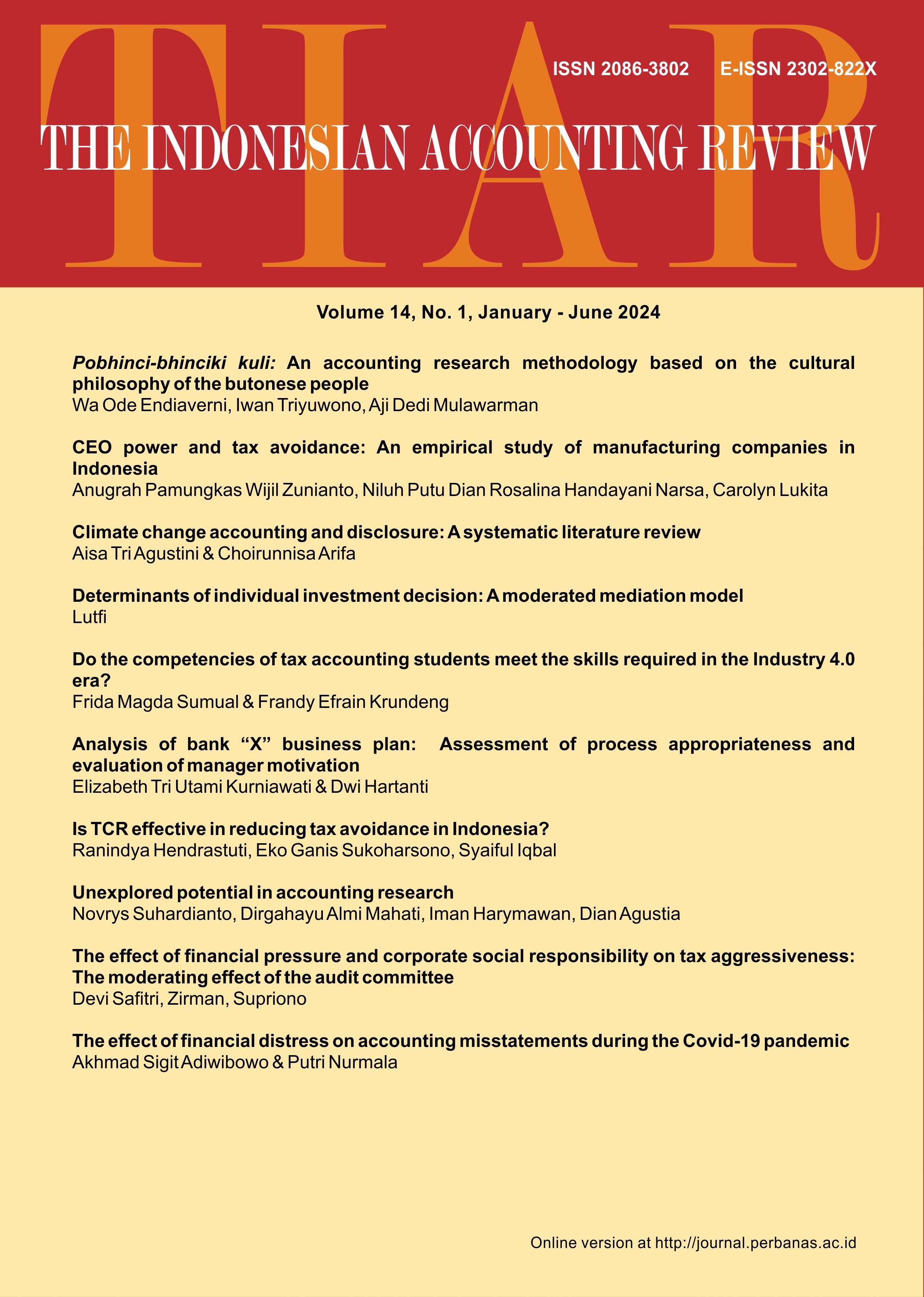Is TCR effective in reducing tax avoidance in Indonesia?
DOI:
https://doi.org/10.14414/tiar.v14i1.4226Keywords:
Tax avoidance, Thin capitalization, Thin capitalization rule, DER rule, Interest to EBITDA ruleAbstract
Thin capitalization is a tax avoidance technique using funding sources that prioritize debt over capital. Thin capitalization can be used as a technique to avoid taxes because there is a difference in treatment between debt and capital as a source of funding in tax regulations. Thin capitalization rule (TCR) is domestic tax system to reduce thin capitalization. This study aims to examine the effect of implementing thin capitalization rules on reducing tax avoidance in Indonesia. This study is a quantitative study. The data used are secondary data obtained from multinational companies listed on the IDX from 2013 to 2020 by excluding companies that are excluded from PMK-169: bank companies, financing institutions, insurance, reinsurance, operating in the oil and gas mining sector, companies whose entire income is subject to final tax, and infrastructure. The data analysis method used in this study is regression using the eviews 12.0 program. The results show that the implementation of thin capitalization rule (TCR) does not reduce tax avoidance. These results provide empirical evidence that the government need to consider using thin capitalization rule with the interest to Earnings Before Interest, Tax, Depreciation, and Amortization (EBITDA) rule mechanism rather than the Debt-to-Equity Ratio (DER) rule mechanism and arm’s length rule mechanism.
References
Adhikari, A., Derashid, C., & Zhang, H. (2006). public policy, political connections, and effective tax rates: longitudinal evidence from Malaysia. Journal of Accounting and Public Policy, 25(5), 574–595. https://doi.org/10.1016/j.jaccpubpol.2006.07.001.
Ali, M., Fjeldstad, O.-H., & Sjursen, I. H. (2014). To pay or not to pay? Citizens’ attitudes toward taxation in Kenya, Tanzania, Uganda, and South Africa. World Development, 64, 828–842. https://doi.org/10.1016/j.worlddev.2014.07.006.
Allingham, M. G., & Sandmo, A. (1972). Income tax evasion: a theoretical analysis. Journal of Public Economics, 1(3–4), 323–338. https://doi.org/10.1016/0047-2727(72)90010-2.
Anindita, R. I., Irawan, F., Firmansyah, A., Wijaya, S., Qadri, R. A., Sumantri, J., Andriani, A. F., & Mahrus, M. L. (2022). The impact of thin capitalization rules on capital structure and tax avoidance. Journal of Governance and Regulation, 11(2), 8–14. https://doi.org/10.22495/jgrv11i2art1.
Armstrong, C. S., Blouin, J. L., Jagolinzer, A. D., & Larcker, D. F. (2015). Corporate governance, incentives, and tax avoidance. Journal of Accounting and Economics, 60(1), 1–17. https://doi.org/10.1016/j.jacceco.2015.02.003.
Astuti, T. P., & Aryani, Y. A. (2017). Tren penghindaran pajak perusahaan manufaktur di Indonesia yang terdaftar di BEI tahun 2001-2014. Jurnal Akuntansi, 20(3). https://doi.org/10.24912/ja.v20i3.4.
Atmaja, A. B. (2021). Analisis efektivitas peraturan penentuan perbandingan utang dan modal Pmk-169/Pmk.010/2015 Dan Per-25/Pj/2017 terhadap tingkat penghindaran pajak di Indonesia. ABIS: Accounting and Business Information Systems Journal, 9(4). https://doi.org/10.22146/abis.v9i4.70438.
Babberich, N. P. . (2009). The Thin Capitalization Rules and Multinationals Financing and Investment Decision: Evidence from Dutch Legislation. Universeit Rotterdam.
Bell, A., & Jones, K. (2015). Explaining fixed effects: random effects modeling of time-series cross-sectional and panel data. Political Science Research and Methods, 3(1), 133–153. https://doi.org/10.1017/psrm.2014.7.
Blouin, J., Huizinga, H., Laeven, L., & Nicodème, G. (2014). Thin Capitalization Rules and Multinational Firm Capital Structure.
Buettner, T., Overesch, M., & Wamser, G. (2018). Anti profit-shifting rules and foreign direct investment. International Tax and Public Finance, 25(3), 553–580. https://doi.org/10.1007/s10797-017-9457-0.
Chen, S., Chen, X., Cheng, Q., & Shevlin, T. (2010). Are family firms more tax aggressive than non-family firms? Journal of Financial Economics, 95(1), 41–61. https://doi.org/10.1016/j.jfineco.2009.02.003.
Darrough, M., & Ye, J. (2007). Valuation of loss firms in a knowledge-based economy. Review of Accounting Studies, 12(1), 61–93. https://doi.org/10.1007/s11142-006-9022-z.
Darussalam, & Kristiaji, B. (2015). Telaah Konstruktif Debt to Equity Ratio di Indonesia. Ikatan Akuntansi Indonesia LXXXI(4), 1–10.
Darussalam, & Septriadi, D. (2017). Perjanjian Penghindaran Pajak Berganda: Panduan, Interpretasi, dan Aplikasi. PT Dimensi Internasional Tax.
De Mooij, R., & Hebous, S. (2018). Curbing corporate debt bias: Do limitations to interest deductibility work? Journal of Banking & Finance, 96, 368–378. https://doi.org/10.1016/j.jbankfin.2018.07.013.
de Mooij, R., & Liu, L. (2021). At a cost: the real effects of thin capitalization rules. Economics Letters, 200, 109745. https://doi.org/10.1016/j.econlet.2021.109745.
De Simone, L., Nickerson, J., Seidman, J., & Stomberg, B. (2020). How Reliably Do Empirical Tests Identify Tax Avoidance? Contemporary Accounting Research, 37(3), 1536–1561. https://doi.org/10.1111/1911-3846.12573.
Deegan, C. (2014). Financial Accounting Theory. Fourth Edition. Mc-Graw Hill Education.
Desai, M. A., & Dharmapala, D. (2008). Tax and corporate governance: an economic approach. Springer Berlin Heidelberg.
Devi, S., Warasniasih, N. M. S., Masdiantini, P. R., & Musmini, L. S. (2020). The impact of covid-19 pandemic on the financial performance of firms on the Indonesia Stock Exchange. Journal of Economics, Business, & Accountancy Ventura, 23(2), 226–242. https://doi.org/10.14414/jebav.v23i2.2313.
Dyreng, S. D., Hanlon, M., & Maydew, E. L. (2008). Long-run corporate tax avoidance. The Accounting Review, 83(1), 61–82. https://doi.org/10.2308/accr.2008.83.1.61.
Dyreng, S. D., Hanlon, M., & Maydew, E. L. (2010). The effects of executives on corporate tax avoidance. The Accounting Review, 85(4), 1163–1189. https://doi.org/10.2308/accr.2010.85.4.1163.
Egger, P., Eggert, W., Keuschnigg, C., & Winner, H. (2010). Corporate taxation, debt financing and foreign-plant ownership. European Economic Review, 54(1), 96–107. https://doi.org/10.1016/j.euroecorev.2009.06.007
Eisenhardt, K. M. (1989). Agency Theory: an assessment and review. Academy of Management Review, 14(1), 57–74. https://doi.org/10.5465/amr.1989.4279003.
Feulefack Kemmanang, L. (2021). Does resource dependence cushion the impact of thin capitalization rules on foreign investment inflows? Evidence from Africa. Resources Policy, 72, 102055. https://doi.org/10.1016/j.resourpol.2021.102055.
Field, A. P. (2018). Discovering Statistics Using IBM SPSS Statistics (5th ed.). Sage.
Graham, J. R., Hanlon, M., Shevlin, T., & Shroff, N. (2014). Incentives for tax planning and avoidance: evidence from the field. The Accounting Review, 89(3), 991–1023. https://doi.org/10.2308/accr-50678.
Gujarati, D. N., & Porter, D. (2009). Basic Econometrics (5th ed.). McGraw Hill Inc.
Hair, J. F., Black, W. C., Babin, B. J., & Anderson, R. E. (2019). Multivariate Data Analysis (8th ed.). Cengage.
Hanlon, M., & Heitzman, S. (2010). A Review of tax research. Journal of Accounting and Economics, 50(2–3), 127–178. https://doi.org/10.1016/j.jacceco.2010.09.002.
Hanlon, M., Maydew, E. L., & Saavedra, D. (2017). The taxman cometh: does tax uncertainty affect corporate cash holdings? Review of Accounting Studies, 22(3), 1198–1228. https://doi.org/10.1007/s11142-017-9398-y.
Henry, E., & Sansing, R. (2018). Corporate tax avoidance: data truncation and loss firms. Review of Accounting Studies, 23(3), 1042–1070. https://doi.org/10.1007/s11142-018-9448-0.
Hutchens, M., & Rego, S. O. (2012). Tax risk and the cost of equity capital. SSRN Electronic Journal. https://doi.org/10.2139/ssrn.2186564.
Jatmiko, V. B., & Husodo, Z. A. (2019). The impact of thin capitalization rule on capital structure. Proceedings of the 12th International Conference on Business and Management Research (ICBMR 2018). https://doi.org/10.2991/icbmr-18.2019.15.
Jensen, M. C., & Meckling, W. H. (1976). Theory of the firm: managerial behavior, agency costs and ownership structure. Journal of Financial Economics, 3(4), 305–360. https://doi.org/10.1016/0304-405X(76)90026-X.
Joos, P., & Plesko, G. A. (2005). Valuing loss firms. The Accounting Review, 80(3), 847–870. https://doi.org/10.2308/accr.2005.80.3.847.
Kasmir. (2012). Analisis Laporan Keuangan. Raja Grafindo Persada.
Kirchler, E., Hoelzl, E., & Wahl, I. (2008). Enforced versus voluntary tax compliance: the “slippery slope” framework. Journal of Economic Psychology, 29(2), 210–225. https://doi.org/10.1016/j.joep.2007.05.004.
Klein, A., & Marquardt, C. A. (2006). Fundamentals of accounting losses. The Accounting Review, 81(1), 179–206. https://doi.org/10.2308/accr.2006.81.1.179.
Kraus, A., & Litzenberger, R. H. (1973). A State-preference model of optimal financial leverage. The Journal of Finance, 28(4), 911. https://doi.org/10.2307/2978343.
Kurniawan, A. (2018). Pengaturan pembebanan bunga untuk mencegah penghindaran pajak. Simposium Nasional Keuangan Negara. Simposium Nasional Keuangan Negara, 1(1), 285–303.
Levenko, N., & Staehr, K. (2023). Self-reported tax compliance in post-transition Estonia. Economic Systems, 47(3), 101047. https://doi.org/10.1016/j.ecosys.2022.101047.
Maha Putra, D., & Putri Kirana, A. (2023). Impact of leverage, capital intensity, inventory intensity, cash effective tax rate on tax avoidance: assessment for energy sector corporate. Atestasi : Jurnal Ilmiah Akuntansi, 6(2), 419–433. https://doi.org/10.57178/atestasi.v6i2.4.
Merlo, V., Riedel, N., & Wamser, G. (2020). The impact of thin-capitalization rules on the location of multinational firms’ foreign affiliates. Review of International Economics, 28(1), 35–61. https://doi.org/10.1111/roie.12440.
Myers, S. C. (2001). Capital Structure. Journal of Economic Perspectives, 15(2), 81–102. https://doi.org/10.1257/jep.15.2.81.
Myers, S. C., & Majluf, N. S. (1984). Corporate financing and investment decisions when firms have information that investors do not have. Journal of Financial Economics, 13(2), 187–221. https://doi.org/10.1016/0304-405X(84)90023-0.
Nathania, C., Wijaya, S., Hutagalung, G., & Simorangkir, E. N. (2021). The influence of company size and leverage on tax avoidance with profitability as intervening variable at mining company listed in indonesia stock exchange period 2016-2018. International Journal of Business, Economics and Law, 24(2), 132–140.
Nordlöf, H., Wijk, K., & Westergren, K.-E. (2015). Perceptions of Work Environment Priorities: are There any Differences by Company Size? An Ecological Study. Work, 52(3), 697–706. https://doi.org/10.3233/WOR-152123.
Nugrahadi, E. W., & Rinaldi, M. (2021). The Effect of Capital Intensity and Inventory Intensity on Tax Avoidance at Food and Beverage Subsector Companies Listed on the Indonesia Stock Exchange (IDX). https://doi.org/10.2991/aebmr.k.210220.039.
OECD. (2012). Thin Capitalisation Legislation: A Background Paper of Country Tax Administration.
OECD. (2022). Revenue Statistics Asia and Pacific - Indonesia. https://www.oecd.org/tax/tax-policy/revenue-statistics-asia-and-pacific-indonesia.pdf.
Overesch, M., & Wamser, G. (2010). Corporate tax planning and thin-capitalization rules: Evidence from a quasi-experiment. Applied Economics, 42(5), 563–573. https://doi.org/10.1080/00036840701704477.
Prastowo, J. A., & Christiawan, Y. J. (2121). Pengaruh Pandemi Covid-19 Terhadap Pemberian Opini Going Concern Dengan Profitabilitas Dan Leverage Sebagai Variabel Mediasi [Universitas Petra]. https://publication.petra.ac.id/index.php/akuntansi-bisnis/article/viewFile/12303/10784.
Ramadhan, M. R. (2023). The impact of thin capitalization rule on tax avoidance in Indonesia. Journal of Accounting and Investment, 24(2), 323–335. https://doi.org/10.18196/jai.v24i2.17036.
Ramadhan, M. R., Frandyanto, S. ., & Riandoko, R. (2017). Pengaruh Thin capitalization Rule pada Leverage Perusahaan di Indonesia: Studi Perbandingan antara Perusahaan yang Memiliki Debt to Equity Ratio lebih dari 4: 1 dan kurang dari 4: 1. Seminar Nasional Akuntansi Dan Bisnis, 290–297.
Ramadhan, M. R., & Riandoko, R. . (2017). The Effect Of Thin Capitalization Rule To Corporate Capital Structure In Indonesia. JMBI UNSRAT (Jurnal Ilmiah Manajemen Bisnis Dan Inovasi Universitas Sam Ratulangi)., 4(3). https://doi.org/10.35794/jmbi.v4i3.17992.
Rego, S. O., & Wilson, R. (2012). Equity Risk Incentives and Corporate Tax Aggressiveness. Journal of Accounting Research, 50(3), 775–810. https://doi.org/10.1111/j.1475-679X.2012.00438.x.
Richardson, G., & Lanis, R. (2007). Determinants of the variability in corporate effective tax rates and tax reform: Evidence from Australia. Journal of Accounting and Public Policy, 26(6), 689–704. https://doi.org/10.1016/j.jaccpubpol.2007.10.00.
Santana, S. L. L., & Rezende, A. J. (2016). Corporate tax avoidance and firm value: evidence from Brazil. Revista Contemporânea de Contabilidade, 13(30), 114-121. https://doi.org/10.5007/2175-8069.2016v13n30p114.
Saragih, A., Purnasari, D., & Setyowati, M. (2019). The Impact of Thin Capitalization on Effective Tax Rate of Companies Listed on Indonesia Stock Exchange in 2009-2017 “The Impact of Thin Capitalization on Effective Tax Rate of Companies Listed on Indonesia Stock Exchange. Journal of Applied Economic Sciences (JAES), 64(2), 505–514. https://doi.org/10.14505/jaes.v14.2(64).18.
Scott, W. . (2015). Financial Accounting Theory (Seventh Ed). Pearson Prentice Hall.
Sekaran, U., & Bougie, R. (2016). Research Methods For Business: A Skill Building Approach (7th Edition). John Wiley & Sons, Ltd.
Shevlin, T. J., Urcan, O., & Vasvari, F. P. (2013). Corporate tax avoidance and public debt costs. SSRN Electronic Journal. https://doi.org/10.2139/ssrn.2228601.
Sogorb-mira, J. A. C. F. (2016). The effect of taxes on the debt policy of spanish listed companies. SERIEs. https://doi.org/10.1007/s13209-016-0147-4.
Susanti, C. M. (2019). Pengaruh konservatisme, leverage, profitabilitas, ukuran perusahaan terhadap tax avoidance. Jurnal Informasi, Perpajakan, Akuntansi, Dan Keuangan Publik, 13(2), 181–198. https://doi.org/10.25105/jipak.v13i2.5021.
Susilawati, N. (2019). Making better Indonesia’s thin capitalization rules (lesson learn from China). In ACHITS 2019: Proceedings of the 1st Asian Conference on Humanities, Industry, and Technology for Society, ACHITS 2019, 30-31 July 2019, Surabaya, Indonesia (p. 8). European Alliance for Innovation., 8.
Syahidah, S., & Rahayu, N. (2018). Thin capitalization rules di Indonesia, studi kasus pada RS X. Sumber Artikel Akuntansi Auditing Dan Keuangan Vokasi, 2(2), 157–176.
Taylor, G., & Richardson, G. (2013). The determinants of thinly capitalized tax avoidance structures: Evidence from Australian firms. Journal of International Accounting, Auditing and Taxation, 22(1), 12–25. https://doi.org/10.1016/j.intaccaudtax.2013.02.005.
Tobing, H. (2018). Pengaruh ukuran perusahaan, ROA, leverage, capital intensity dan inventory intensity terhadap tarif pajak efektif. IEEE Communications Surveys and Tutorials, 15, 2046–2069.
Tooma, R. A. (2008). Legislating Against Tax Avoidance. IBFD.
Wardani, D. K. (2020). Dampak riil penghindaran pajak pada perusahaan manufaktur di Bursa Efek Indonesia. Akmenika: Jurnal Akuntansi Dan Manajemen, 17(1), 1-10. https://doi.org/10.31316/akmenika.v17i1.678.
Yasa, I. M. ., & Wicaksana, K. A. . (2017). Analisis penerapan Pmk 169/Pmk. 010/2015 pada PT Bali Lestari. Jurnal Bisnis Dan Kewirausahaan, 12(3), 165-173.
Zaina. (2017). Thin capitalization rules, firm’s financing decision, and corporate tax avoidance in developing country: Evidence from Indonesia. In Erasmus School of Economics Journal. http://hdl.handle.net/2105/41051.
Zimmer, F. (2002). Cahiers de Droit Fiscal International:Form and Substance in Tax Law (International Fiscal Association Staff (ed.)). Springer Netherlands.
Zimmerman, J. L. (1983). Taxes and firm size. Journal of Accounting and Economics, 5(1), 119–149.
Downloads
Submitted
Published
How to Cite
Issue
Section
License
Copyright (c) 2024 The Indonesian Accounting Review

This work is licensed under a Creative Commons Attribution-NonCommercial 4.0 International License.


















